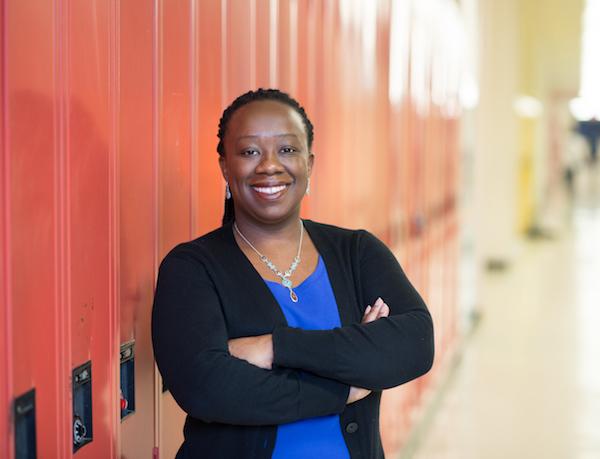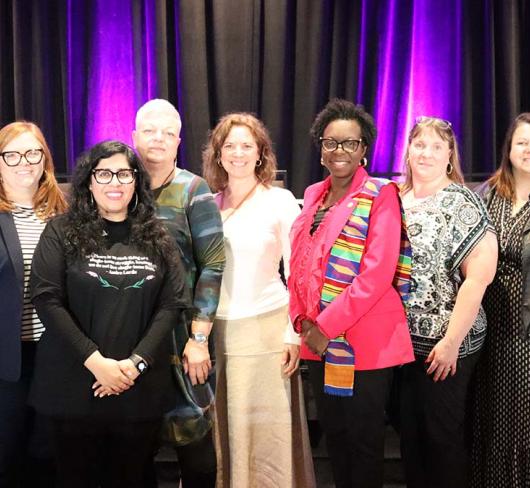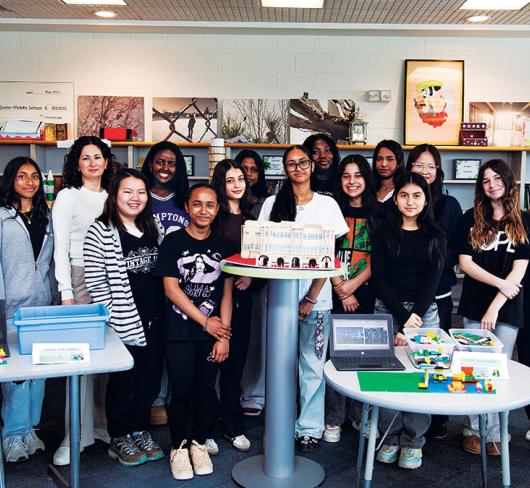
Beyond Black History Month
I recently participated in a curriculum workshop for teachers hosted by Natasha Henry. The focus was how to incorporate African Canadian history throughout the year and across curricular areas. The workshop was engaging and informative, and challenged the way I had viewed the use of cultural histories in my own teaching. Her research into new ways to incorporate African Canadian history in everyday curriculum is inspiring. A dedicated educator and historian, Natasha has applied her research to the classroom. She has produced articles, books and teaching resources, as well as the workshop series I first attended, to support students and teachers in maintaining connections to the stories of Black Canadians.
LB: How did you come to write about Black history? Did you find that there were gaps in the curriculum?
NH: I did find gaps in the curriculum. First, when I was a student in Toronto I did not see or hear much about Black history. I had questions about the Black presence in Canada and how long Black people had been here. My own parents were immigrants to Canada. I wondered how far back the immigration of Blacks to Canada went. Were Black people here before my family immigrated to Canada? Where did they live; what did they do? I wanted to understand what it meant to be Black in Canada and to locate myself on the Canadian landscape as a person of African descent born in Canada. So I started seeking out the information for myself. When I became a teacher, the community where I taught had a large Black population. I felt a more inclusive curriculum would help my students better connect with their learning. This is where I began to develop the curriculum resources that I shared with my colleagues. The gap I identified when I was a student was still present and I wanted my students to have a different experience.
LB: Can you talk about the importance of students seeing themselves reflected in their curriculum?
NH: Well, students really feel a sense of pride when they see themselves reflected in the curriculum. It helps them identify as Canadian, especially when, sometimes, students don’t feel like they’re a part of the history taught in the classroom. Or they are made to feel that they don’t belong. When you learn more about your ancestors, those who’ve gone before you, and what they’ve accomplished, it’s empowering! If you’re envisioning something for yourself, it doesn’t look so impossible when others before you have accomplished so much. Understanding their hardships and the obstacles they faced and overcame helps students see better futures for themselves and believe in themselves.
I will give you an example. As part of the preparation for a Black History Month assembly, a teacher for a grade 2 class developed a script for her students to present in first-person as various African Canadians, past and present. I suggested the focus on Blacks in Canada because there is always this tendency to teach about African Americans
in Canadian classrooms, disregarding the rich, storied history that Blacks have here. The students dressed up in role, and presented their lines speaking as the person they were assigned, for instance, “I am Harriet Tubman,” “I am George Dixon,” “I am Elijah McCoy,” or “I am Viola Desmond.” They went on to share a few of that person’s challenges and accomplishments. They connected with the narratives they learned about and presented so well that even today, four years later, many of those students remember the person with a sense of pride and accomplishment. African Canadian students don’t always get the chance to see these images, these historical connections to themselves, particularly within the Canadian context. As educators, we talk about culturally relevant and responsive pedagogy and students seeing themselves in the curriculum. I feel it helped bring a sense of cultural relevancy to the students at the time.
LB: Do you integrate Black history into all aspects of the curriculum or just Social Studies?
NH: In the past, I’ve made connections with students in science introducing students to inventors or scientists who are Black. I’ve also introduced Black novelists in Language Arts to broaden the scope of how Blacks are represented. For History and Geography, you can make connections with immigration and the movement of Blacks into Canada, which continues today. A specific activity I did with my students was using historical information on Africville, N.S. to explore the ideas presented in the novel Last Days of Africville, a story of Africville seen through the eyes of one young girl.
LB: How does writing and doing research on Black history fit into your teaching practice?
NH: It fits into my teaching practice in many ways. First, it enhances my ability to diversify the presentation of the curriculum and enables me to deliver a more culturally responsive program. It also makes me more cognizant of the omissions and gaps in content. Incorporating the experiences of Blacks into my teaching helps my students develop critical thinking skills. Many questions arise when they encounter some of the information for the first time and they become engaged in finding out the answers. Another way it fits is in doing my part in implementing the government-mandated equity agenda. We can’t talk about equity and social justice without looking at and gaining an indepth understanding of Black experience in Canada, without including these stories.
LB: What specific ideas and themes do you explore with your students?
NH: One theme I often bring in is that of Black contributions to the field of science, for example Black inventors, to bring a different perspective. However, even when there may not be specific ideas or themes, we need to present and help our students to see the content through as many different voices as possible, to represent the experiences and cultures of our students, and the contributions of all Canadians.
Specifically related to African Canadian history, the critical idea is the inclusion of the Black experience in all its diversity. The history of Blacks in Canada is by no means homogeneous. There were free Blacks, those who were enslaved, refugees and immigrants, Black children and Black adults, male and female. Blacks worked in a range of occupations and owned all kinds of business. In a general sense, it’s being conscious of whose stories are told, whose voices we’re silencing, and ensuring everyone is heard.
LB: How do you connect Black history with what is happening around us today – social movements like Black Lives Matter?
NH: Students need to understand that there is a legacy in regards to the enslavement of Africans, the treatment of Blacks in North America and the laws and practices from the Jim Crow era, including here in Canada. The issues that Black people face today are linked to the history of individual, systemic and institutionalized racism. There was a point in time when African people were not considered to be fully human, bought and sold as property, and treated as second-class citizens. What we see happening today is rooted in that history of anti-Black racism and we do an injustice to our students if we try to ignore it, to sweep it under the rug. We need to strive to find age-appropriate ways to make these connections because students do have questions and emotional responses to these issues that are covered in the media. When connections can be made to history, the understanding of why Blacks respond they way they do and why they experience what they do becomes clearer.
There are links too with the current refugee crisis in Syria. In a discussion with a class, one student made the connection between enslaved Blacks who escaped bondage to be free and the refugees from Syria, which opened up a conversation with the whole class. They understood clearly that people from different backgrounds, from different parts of the world, who suffer hardships and who are mistreated for who they are, are willing to flee horrible conditions, risk their lives, so they and their families can live better lives. Links can be made in various ways using different themes. Elements of the experiences of Blacks can be applied as needed; Black history isn’t limited to just Social Studies or February, Black History Month. In core classes, it is easier to integrate Black history in a cross-curricular manner, but including the voices and stories of people of African descent who’ve contributed and accomplished so much can also be done when teaching subjects such as math and science.
LB: What would you say to teachers who want to include more Black history in their classrooms?
NH: I would say to teachers who want to be more inclusive of a diversity of voices and want to share the ideals of equity with their students, this can’t truly be achieved in our Canadian context without including African Canadian history. What I mean by this is, people can’t get the full picture of how human rights legislation came to exist in Ontario without learning about the persistent struggles of Blacks to be treated fairly and equally when seeking an education for their children, when applying for a job, when hoping to immigrate to Canada, when enlisting in the Canadian military, and when seeking service from a business or government agency that serves the public. It’s due to their efforts to challenge racial discrimination and get laws enacted that support the rights of all that we have a better society today.
We tend to rely on American content, but I’d encourage teachers to use Canadian content as much as possible, to help Canadian students to understand Canadian history. There is more content becoming available all the time. Also, be prepared to be uncomfortable, as there will be issues raised that require a teacher to learn right along with her students. Don’t shy away from the discussion; having those conversations is important and beneficial to the students as well as the teacher.
LB: Are there resources you would recommend to your colleagues?
NH: Yes, there are many that I could share, but I’ll only name a few. The Sankofa Black Heritage Collection (sankofacollection.com) is one of the latest resources. It’s a series of 15 books written for audiences from grades 4-8.
It’s a great series that focuses on representing the African Canadian experience and the African diaspora. It provides real opportunities to make connections.
The Book of Negroes miniseries and the supporting teacher guide are great resources. Teachers have access to these through CBC Curio Learning (curio.ca/en/collection/thebook- of-negroes-1932/).
The Richard Pierpoint Heritage Minute along with the resources help teachers use a powerful 1-minute visual in the class and make connections to Black Loyalists, slavery in Canada and media literacy (thecanadianencyclopedia. ca/en/studyguide/richardpierpoint- heritage-minute/).
There is also the Black History in Canada Education Guide (blackhistorycanada.ca/ education/LearningTools.pdf).
The National Film Board has a range of amazing resources to incorporate aspects of Black history, from animated films such as Joe, Black Soul, Christopher Changes His Name and Christopher, Please Clean Up Your Room!, to documentaries like Journey to Justice, The Road Taken, Speakers for the Dead and Dresden Story.
When I worked at the Harriet Tubman Institute, we developed two groundbreaking projects on African Canadian history that use digital storytelling – Breaking the Chains: Presenting a New Narrative for Canada’s Role in the Underground Railroad and We Stand on Guard for Thee: Teaching and Learning the African Canadian Experience in the War of 1812 (tubman.info.yorku.ca/educationalresources/).
And lastly, the Archives of Ontario has a number of online lesson plans, online exhibits and onsite education workshops on Black history (archives.gov.on.ca/en/education/lesson_ plans_themes.aspx#black_history).
I’ve compiled some resources teachers can use on my website “Teaching African Canadian History” and continue to add to it from time to time (teachingafricancanadianhistory. weebly.com/).
Lauren Beckford is a member of the Peel Teacher Local.
Natasha Henry is a member of Peel Occasional Teacher Local. She is a curriculum consultant specializing in the development of learning materials that focus on the African diasporic experience. She has written several books and has also contributed several entries to the Canadian Encyclopedia on African Canadian history. Natasha has developed the educational resources for several exhibits and web-based projects on the Black experience in Canada, including the CBC miniseries The Book of Negroes. She facilitates workshops for teachers and students on Black history.

